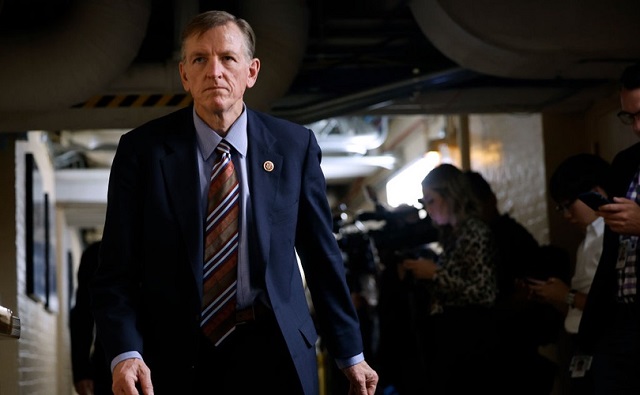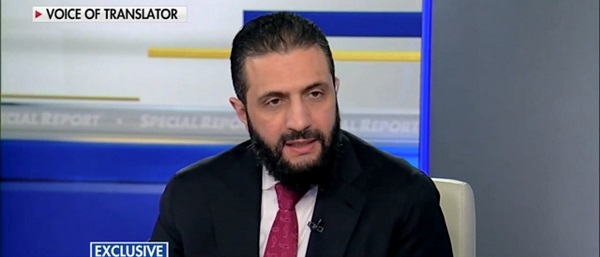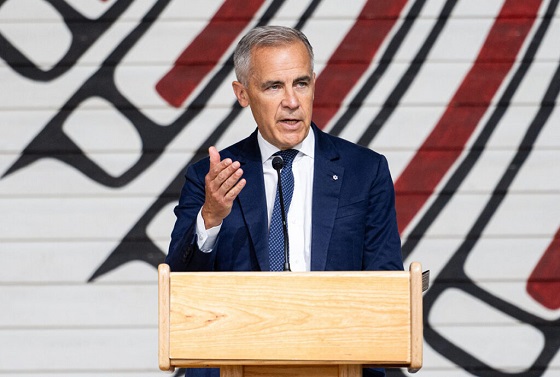International
Rep. Paul Gosar grills Biden official on government funding of underage ‘gender transitions’

U.S. Rep. Paul Gosar of Arizona.
From LifeSiteNews
“I thought the USA was better than that. I thought we were the leaders in science, not followers. I find it disgusting that you still sit there and hide behind that”
The federal government is funding underage “gender reassignment” procedures for the families of government employees and has no interest in keeping track of how many, according to a recent exchange between U.S. Rep. Paul Gosar (R-AZ) and Rob Shriver, acting director of the U.S. Office of Personnel Management (OPM).
During a hearing Tuesday of the House Oversight & Accountability Committee, Gosar pressed Shriver on the Federal Employees Health Benefits Program (FEHB) contracting with health plans that commit surgical and chemical “transition” procedures on children suffering from gender confusion – particularly at a time when the United Kingdom and other European governments are moving away from the practices in response to mounting evidence of their medical dangers that U.S. authorities continue to ignore.
Shriver responded that “the health plans that participate in the FEHB decide on the benefit packages that they make available,” claiming that his office had no authority over the specific benefits of FEHB plans. Gosar was incredulous that he was essentially “allowing a bad product to go forward here,” then noted that FEHB actually mandated coverage of “gender transitions” or “sex transformation” in a 2016 program carrier letter.
Citing restrictions on puberty blockers adopted in recent years by Denmark, England, Finland, Norway, and Sweden, the congressman lamented, “I thought the USA was better than that. I thought we were the leaders in science, not followers. I find it disgusting that you still sit there and hide behind that, when children are being mutilated.”
Shriver also deflected Gosar’s call for “greater transparency” and data collection on children being “transitioned” through FEHB health plans, noting that former OPM director Kiran Ahuja, who stepped down earlier this month for reported health and family issues, previously refused to mandate reporting on how many children receive the “services.”
Gosar previously introduced language to deny taxpayer funding to any FEHB plan that covered “gender transitions” in the most recent government appropriations package, but it was cut from the final version that was signed into law in March.
Contrary to the Biden administration’s pretense of acting in children’s best interests, a significant body of evidence shows that “affirming” gender confusion carries serious harms, especially when done with impressionable children who lack the mental development, emotional maturity, and life experience to consider the long-term ramifications of the decisions being pushed on them, or full knowledge about the long-term effects of life-altering, physically transformative, and often irreversible surgical and chemical procedures.
Studies find that more than 80% of children experiencing gender dysphoria outgrow it on their own by late adolescence, and that full “reassignment” surgery fails to resolve gender-confused individuals’ heightened tendency to engage in self-harm and suicide — and may even exacerbate it, including by reinforcing their confusion and neglecting the actual root causes of their mental strife.
The Biden administration’s own Substance Abuse & Mental Health Services Administration (SAMHSA) released a since-deleted report last year acknowledging that self-professed homosexual and bisexual adults “are more likely than straight adults to use substances, experience mental health conditions including major depressive episodes, and experience serious thoughts of suicide.”
Yet the White House continues to give uncompromising support to all major aspects of the LGBT agenda, including reopening the military to recruits afflicted with gender dysphoria, promoting gender ideology within the military (including “diversity” and drag events on military bases), holding White House events to “affirm transgender kids,” condemning state laws against underage “transitions” as “close to sinful,” promoting underage “transitions” (potentially at taxpayer expense) as a “best practice,” and trying to force federally funded schools to let males into female athletic competitions and restrooms.
International
Wealthy tourists allegedly paid money to ‘massacre’ civilians in Bosnia during the 1990s

From LifeSiteNews
The tourists allegedly paid £70,000 to gun down civilians during the Bosnian War of 1992-1995, with the Serbs charging extra to shoot children.
Italian prosecutors are investigating claims that wealthy Western tourists embarked on so-called “human safari” hunting trips to the Bosnian capital of Sarajevo during the Bosnian War of 1992-1995. According to press reports, rich “manhunters” allegedly “paid members of the Bosnian Serb army for weekend trips to the besieged city where they participated in the massacre of residents for pleasure.”
The wealthy tourists allegedly paid £70,000 to gun down civilians during the four-year siege of Sarajevo, in which over 10,000 people died by shelling and sniper fire; the Serbs charged extra to shoot children. The Daily Mail stated that Milanese prosecutors are looking into the “wealthy foreign gun enthusiasts” who traveled to the warzone for “sniper tourism” by flying from Trieste to Belgrade on the Serb airline Aviogenex and were charged up to £88,000.
The claims originated in a 2022 documentary by Slovenian filmmaker Miran Zupanic titled Sarajevo Safari, in which he explored claims that wealthy customers from Italy and other nations flew in to gun down innocent people during the Bosnian nightmare. The tourists allegedly paid members of Radovan Karadžić’s army to escort them to the surrounding the city, where they would set up position and fire at residents. Karadžić was recently sentenced to 40 years in prison for genocide.
The documentary claims that the “safari manhunters” came from Canada, the United States, France, Germany, and Russia, as well as Italy.
The claims are difficult to parse because the killing of civilians by Serb snipers was incredibly common, with the infamous “Sniper Alley” Meša Selimović Boulevard, the main road into the city, turning into a shooting range for the besiegers. The claims in the film are based on the testimony of a Slovenian who worked for an American agency during the war; a retired Bosnian intelligence officer; and three surviving victims. A U.S. Marine also recounted seeing wealthy non-military snipers being escorted into the warzone.
The tourists, described by one interviewee as “bored millionaires” who wanted to hunt people like they “hunted deer,” were allegedly taken by Serb military personnel through UN-protected routes or tunnels, sometimes disguised as aid workers or journalists, sometimes wearing civilian clothing. Estimates indicate dozens of tourists involved, with potentially hundreds of civilian victims.
Now a 17-page legal complaint has been submitted by Milanese writer and journalist Ezio Gavazzeni, with backing from Guido Salvini, a former magistrate, and Benjamin Karic, who served as mayor of Sarajevo from 2021 to 2024. Gavazzeni stated that the Bosnian Attorney General had “shelved an investigation into the ‘sniper tourism’” due to “the difficulty of probing such a case in a country still deeply scarred and divided by war,” although the Bosnian authorities have promised full cooperation with the case.
“We are talking about wealthy people, with reputations—businessmen—who during the siege of Sarajevo paid to kill unarmed civilians. They left Trieste for a manhunt and then returned to their respectable daily lives,” Gavazzeni told the press. The Serbs have denied the allegation, calling it “propaganda”; the Hague Tribunal found insufficient evidence.
Lead prosecutor Alessandro Gobbi, however, is “understood to have a list of several people who can provide testimony,” and Gavazenni stated that up to 100 tourists could have been involved; the case specifically cites the Milanese owner of a cosmetic surgery clinic, as well as others from Trieste and Turin. A Bosnian intelligence agent, says Gavazenni, has agreed to serve as a witness, and has claimed that classified files with evidence are still in existence.
According to the Daily Mail: “Other witnesses include a Slovenian intelligence official, victims, and a wounded firefighter who, during the 2002 trial of Serbian leader Slobodan Milosevic in The Hague, described ‘tourist shooters’ with distinctive clothing and weapons that distinguished them from Serbian soldiers.” Now these claims will finally get the thorough investigation that has long been badly needed.
Energy
Canada’s oilpatch shows strength amid global oil shakeup

This article supplied by Troy Media.
Global oil markets are stumbling under too much supply and too little demand but Canada’s energy sector is managing to hold its own
Oil prices are sliding under the weight of global oversupply and weakening demand, but Canada’s oilpatch is holding steady—perhaps even thriving—as others flounder.
Crude is piling up in tankers, major producers are flooding the system, and demand is fading fast. According to a Windward report cited by Oilprice.com, the amount of oil held in floating storage—tankers sitting offshore waiting for buyers —has hit record highs. Sanctions on Russian and Iranian crude have sidelined entire fleets. Meanwhile, Middle East cargoes continue to pour in, keeping global supply bloated.
Gunvor CEO Torbjorn Tornqvist called the scale “unprecedented,” warning the market would be flooded overnight if sanctions against Russian and Iran were lifted.
And there’s more coming. U.S. crude production has hit a new record of 13.8 million barrels per day in August. And China’s Changqing oilfield just surpassed 20 million tonnes in cumulative output, and national totals have topped 400 million tonnes of oil equivalent this year. More barrels. More pressure. Less price support.
At the same time, demand is slipping. U.S. gasoline use is down. Global shipping activity has slowed. JPMorgan just trimmed its 2025 oil demand forecast by 300,000 barrels per day. China’s manufacturing sector shrank for the seventh month in a row.
Japan’s purchasing index dropped to an 18-month low. And recession fears are back in the headlines.
OPEC+ tried to calm the chaos by announcing a modest increase in output this December, with a pause on future hikes. But the move didn’t move markets. Then Saudi Arabia cut its selling prices to Asia, a clear signal that the kingdom sees weak demand ahead.
In short, it’s messy out there. But not everywhere.
Amid this global downturn, Canada’s energy sector stands out for one rare quality: resilience. While other producers are scaling back or scrambling to adapt, Canada’s oilpatch is quietly outperforming.
A recent CBC News report highlighted the sector’s staying power and why it’s better positioned than its U.S. counterparts. “The companies that have survived here are the companies that have been able to adapt,” said Patrick O’Rourke, managing director at ATB Capital Markets. “It’s effectively Darwinism.”
It’s also smart design. Canada’s oilsands—primarily in Alberta—are expensive to build but cheap to run. Once the upfront costs are covered, producers can keep pumping for decades with relatively low reinvestment. That means even in a
downturn, output stays strong.
Dane Gregoris of Enverus says Canada’s conventional sector is holding up better than the U.S. shale patch. Why? Canadian oil producers operate more efficiently, with fewer legal and logistical barriers tied to land access and ownership than their U.S. shale counterparts. They also benefit from lower operating costs and are less dependent on relentless drilling just to maintain output.
And now, they finally have a way to get more oil out.
The long-delayed Trans Mountain pipeline expansion is finally complete. It delivers Alberta crude to B.C.’s tidewater and, from there, to Asian markets. That access, once a significant limitation for Canadian producers, is now a strategic advantage. It’s already helping offset lower global prices.
Canada’s energy sector also benefits from long-life assets, slow decline rates and political stability. We have a reputation for responsible regulation, but that same system can slow development and limit how quickly we respond to shifting global demand. We can offer a stable, secure supply but only if infrastructure and regulatory hurdles don’t block access to it.
And for Canadians, that matters. Oil prices don’t just fuel industry headlines; they shape provincial and national budgets, drive investment and underpin jobs across the country. Most producers around the world are bracing for pain but Canada may be bracing for opportunity to expand its presence in Asian markets, secure long-term export contracts and position itself as a reliable supplier in a turbulent global landscape.
None of this means Canada is immune. If demand collapses or sanctions lift, prices could sink further. But in a volatile global landscape, Canada isn’t scrambling—it’s competing.
While others slash forecasts, shut wells or hope for an OPEC rescue, Canada’s energy producers are doing something rare in today’s oil market: holding the line.
Toronto-based Rashid Husain Syed is a highly regarded analyst specializing in energy and politics, particularly in the Middle East. In addition to his contributions to local and international newspapers, Rashid frequently lends his expertise as a speaker at global conferences. Organizations such as the Department of Energy in Washington and the International Energy Agency in Paris have sought his insights on global energy matters.
Troy Media empowers Canadian community news outlets by providing independent, insightful analysis and commentary. Our mission is to support local media in helping Canadians stay informed and engaged by delivering reliable content that strengthens community connections and deepens understanding across the country
-

 Frontier Centre for Public Policy8 hours ago
Frontier Centre for Public Policy8 hours agoRichmond Mayor Warns Property Owners That The Cowichan Case Puts Their Titles At Risk
-

 armed forces19 hours ago
armed forces19 hours agoCanadian veteran says she knows at least 20 service members who were offered euthanasia
-

 Business8 hours ago
Business8 hours agoSluggish homebuilding will have far-reaching effects on Canada’s economy
-

 Business1 day ago
Business1 day agoCarney shrugs off debt problem with more borrowing
-

 Daily Caller2 days ago
Daily Caller2 days agoEx-Terrorist Leader Goes On Fox News, Gives Wild Answer About 9/11
-

 Energy2 days ago
Energy2 days agoFor the sake of Confederation, will we be open-minded about pipelines?
-

 Alberta19 hours ago
Alberta19 hours agoHow economic corridors could shape a stronger Canadian future
-

 Alberta2 days ago
Alberta2 days agoMark Carney Has Failed to Make Use of the Powerful Tools at His Disposal to Get Oil Pipelines Built











